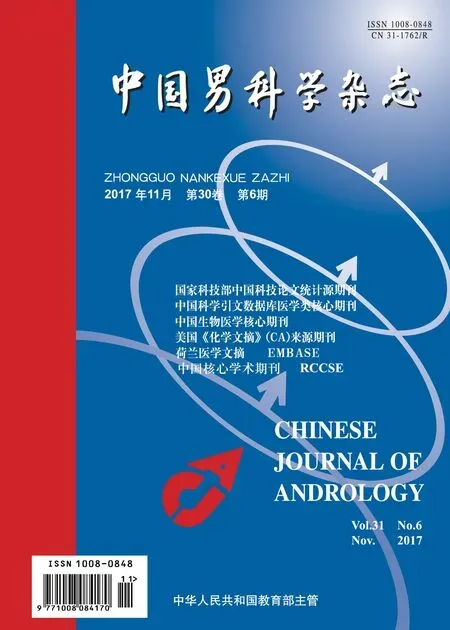血清睾酮值对提高前列腺癌诊断率及预测前列腺癌Gleason评分的临床意义
黎 舵 徐光勇 葛成国 张唯力
重庆医科大学附属第二医院泌尿外科(重庆 400010)
前列腺癌(prostate cancer, PCa)是男性泌尿生殖系统的常见肿瘤,其发病率有明显的地域及种族差异,不仅在欧美国家高居第一,而且在中国的发病率也呈现出逐年的上升趋势[1]。前列腺癌的发生发展与体内雄激素的调控有着密切的相关性[2]。而睾酮(serum testosterone, T)是男性体内最为重要的雄激素。对于晚期前列腺癌及转移性前列腺癌,手术去势及药物去势降低睾酮水平是目前的主要治疗手段。因此,过去人们一直认为高血清睾酮是罹患前列腺癌的高危因素[3]。但最近诸多的研究对这一传统观点提出质疑,研究认为高水平的血清睾酮值并不会增加患前列腺癌的风险[4-7],相反他们认为低水平血清睾酮与前列腺癌检出率,前列腺癌的发生发展以及预测前列腺癌预后密切相关[8-13]。但目前相关研究较少。为了进一步了解血清睾酮值对提高前列腺癌诊断率及预测前列腺癌Gleason评分的临床意义,我们选取了2015年7月至2017年8月于我院行前列腺穿刺的患者91例,进行了相关研究,现在将研究方法及结果汇报如下。
资料与方法
一、一般资料
本研究收集了2015年8月至2017年7月间就诊于重庆医科大学附属第二临床医院泌尿外科行前列腺穿刺且病例资料完整的患者共91例。全部患者都遵循《中国泌尿外科疾病诊断治疗指南2014版》中的前列腺穿刺适应证:(1)直肠指检发现前列腺结节,任何PSA值;(2)B超,CT或MRI发现异常影响,任何PSA值;(3)PSA值>10ng/mL,任何f/tPSA和PSAD值;(4)PSA 4~10ng/mL,f/tPSA或PSAD值异常。其中穿刺结果为前列腺癌的患者41例,作为前列腺癌组;穿刺结果为前列腺增生的患者50例,为前列腺增生组。其中前列腺癌组按Gleason评分分为两组:Gleason评分≥7组和Gleason评分<7组。
二、纳入及排除标准
1. 纳入标准:能正确完成相关检查,经直肠前列腺活检确诊为PCa或BPH,且病历资料完整。
2. 排除标准:(1)有前列腺手术史如激光,消融,球囊扩张,微波,射频等。(2)1月内有前列腺穿刺;1周内行前列腺按摩;48h内行膀胱镜检、导尿等操作;(3)有急性前列腺炎、尿潴留等疾病。
三、穿刺
穿刺前常规清洁灌肠,并按照患者情况,适量服用抗生素预防感染,穿刺前后肌注巴曲亭,减少出血。自动穿刺枪在经直肠超声引导下穿刺,主要穿刺区域为前列腺外周带及病灶明确部位。穿刺针数为6~13针。
四、统计学方法
应用统计学软件SPSS 24.0对定量资料行相关性分析,并对独立样本进行t检验,以P<0.05为差异具有统计学意义。
结 果
一、年龄与血清睾酮水平的关系
对91例患者的年龄及血清睾酮做相关性分析,结果显示两者无明显相关性(P>0.05)。
二、PCa组和BPH组血清睾酮水平的比较
两组间年龄差异无统计学意义(P>0.05);BPH组血清睾酮平均值为368.86ng/dL,高于PCa组为308.39ng/dL,但差异无统计学意义(P>0.05),见表1。

表1 PCa组与BPH组睾酮值的比较
三、Gleason评分≥7组和Gleason评分<7组两组间血清睾酮值的比较
两组间年龄差异无统计学意义(P>0.05),Gleason分≥7组血清睾酮平均值为259.30ng/dL,明显低于Gleason评分<7组血清睾酮平均值375.44ng/dL,两者间差异具有统计学意义(P=0.016),见表2。

表2 Gleason分≥7组和Gleason评分<7组睾酮值的比较
讨 论
一、前列腺癌的诊断现状
前列列腺癌是男性恶性肿瘤之一,世界范围内,前列腺癌发病率在男性所有恶性肿瘤中位居第二[1],在美国前列腺癌已经成为第一位危害男性健康的肿瘤[14]。亚洲前列腺癌的发病率远远低于欧美国家,但值得注意的是,我国前列腺癌的死亡率却远远高于美国,美国白人前列腺癌的发病率达159.9/105,病死率仅为17%,早期诊断率达到80%。然而在我国,前列腺癌的病死率为63%[15]。过低的早期诊断率是导致我国前列腺癌较高病死率的主要原因。而如何有效的提高前列腺癌的早期诊断率将成为降低前列腺癌病死率的重要措施。而目前公认的前列腺癌的早期筛查方法是直肠指检结合前列腺特异性抗原。一直以来,PSA已被广泛运用于前列腺癌的筛查, 这使得前列腺癌的早期诊断率得到明显提高。然而, 作为前列腺癌早期诊断的有效标志物,PSA 的特异性和敏感性均具有一定的局限性。当以血清PSA>4 ng/mL为临界值时,仍有25 %的患者被漏诊[16]。故此,寻找一个特异性和敏感性均较高的诊断标志物,对前列腺癌的早期诊断有着十分重要的临床意义。血清睾酮逐渐进入人们的视野,诸多学者通过相关研究认为血清睾酮水平对前列腺癌的早期诊断具有一定的参考价值。
二、睾酮与前列腺癌的关系
在男性的一生中,血清睾酮水平在青春期开始上升,30岁可到达高峰,40岁后开始逐渐减少。其中90%由睾丸间质细胞分泌,其余部分由肾上腺产生[17,18]。对男性的性欲、性功能、骨代谢、糖代谢及情绪等都有重要的影响[19]。传统观点认为睾酮会增加男性罹患前列腺癌的风险或使隐匿性前列腺癌加速生长,因此降低血清睾酮成为治疗前列腺癌的主要目标。然而近年来的诸多研究结果认为血清睾酮并不会增加发生前列腺癌的风险。2012年Feneley等[20]的研究结果认为血清睾酮不会增加患前列腺癌的风险,2014年Eisenberg等[21]对1989年至2009年的458名患者进行研究,其中247名患者长期接受睾酮治疗,211名患者不接受睾酮替代治疗,结果显示接受睾酮治疗组27名患者患前列腺癌,对照组20名患者患前列腺癌,他们也认为睾酮并不会增加患前列腺癌的风险,同年Kaplan等[22]对美国1991年至2007年被诊断为前列腺癌的149 345位患者进行分析,同样认为睾酮替代治疗并不会提高死亡率。2015年Haider等[23]对1 023名患者的研究中也得出同样的结论。近来也有研究认为低水平血清睾酮会增加前列腺癌的发生风险[24]。Morgentaler等[25]报道了345 例性腺功能减退患者中15% 被诊断为前列腺癌,高于相同年龄层正常人群的前列腺癌发生率。Morgentaler等[26]也发现一定低水平的雄激素可以促进肿瘤细胞的生长。本次研究中虽然前列腺增生组与前列腺癌组血清睾酮水平无显著差异(P=0.06),这可能与本次研究病例数较少,年龄范围过于宽泛,穿刺技巧参差不齐导致穿刺结果存在差异等因素有关。但可以看出,前列腺增生组血清睾酮平均水平明显高于前列腺癌组。相信通过大量的科学、全面的临床研究,血清睾酮可成为前列腺癌早期诊断新的标志物。
三、血清睾酮对预测前列腺癌GS评分的意义
对于血清睾酮水平与前列腺癌病理分级之间的关系也有相关报道。Hoffman等[27]证实,高分级的前列腺癌(Gleason≥8)更有可能在血清睾酮水平<300ng/dL的男性中发现。同时,Schatzl等[28]的一项研究中显示,新诊断为前列腺癌的156名男性中,血清睾酮含量<300ng/dL,其Gleason评分更高。Isom-Batz等[29]在对326名接受根治性前列腺切除术的患者进行分析后认为,较低的术前睾酮水平和晚期的病理分级(P=0.01)之间存在显著的相关性。Mearini和同事们发现[8],在103名被诊断为前列腺癌的患者中,较低的术前血清睾酮水平与前列腺切除术后的更差的病理分级相关联。Massengill等[30]在对879名接受前列腺切除术的前列腺癌患者的研究中,认为较低的血清睾酮水平预示着前列腺癌的Gleason评分越高。另一项研究显示[31]如果PSA 值<10 ng /mL,前列腺癌患者的血清睾酮高于良性前列腺增生患者,在前列腺癌患者中,Gleason 评分7~10 的患者血清睾酮显著低于Gleason 评分在7 以下的患者。本次研究中 对于Gleason分≥7组和Gleason评分<7组两组间血清睾酮值的比较,差异具有统计学意义(P=0.016),提示前列腺癌患者睾酮水平越低,其Gleason评分越高。
综上所述,前列腺癌是目前中老年男性多发肿瘤,严重威胁中老年男性的健康,且早期诊断率较低,如何提高前列腺癌的早期诊断率意义重大,越来越多的证据对血清睾酮与前列腺癌的关系提出挑战。此次研究中可以看出,前列腺增生组血清睾酮平均水平明显高于前列腺癌组。前列腺癌患者血清睾酮水平越低,其Gleason评分越高。虽然目前对于血清睾酮对前列腺癌的诊断及评估预后意义尚无肯定的结论,且相关研究较少,尚需更多的数据支持。但通过本次研究我们认为对于前列腺癌患者其血清睾酮水平有下降趋势,可以与PSA,DRE,影像检查等结合起来对前列腺癌的早期诊断,预测其Gleason评分,评估其预后及选择治疗方案具有一定的参考意义。
前列腺肿瘤; 睾酮
1 Center MM, Jernal A, Lortet-Tieulent J,et al. Iternationnal Variation in prostate cancer incidence and Mortality rates.Eur Urol2012; 61(6): 1079-1092
2 Debes JD, Tindall DJ. The role of and rogens and the androgen receptor in prostate cancer.Cancer Lett2002;187(1-2): 1-7
3 Bhasin S, Storer TW, Berman N,et al. Testosterone replacement increases fat-free mass and muscle size in hypogonadal men.J Clin Endocrinol Metab1997; 82(2):407-413
4 Endogenous Hormones and Prostate Cancer Collaborative Group,Roddam AW, Allen NE,et al. Endogenous sex hormones and prostate cancer: a collaborative analysis of 18 prospective studies.J Natl Cancer Inst2008; 100(3):170-183
5 Wang C, Cunningham G, Dobs A,et al. Long-term testosterone gel (AndroGel) treatment maintains bene fi cial effects on sexual function and mood, lean and fat mass,and bone mineral density in hypogonadal men.J Clin Endocrinol Metab2004; 89: 2085-2098
6 Dean JD, Carnegie C, Rodzvilla J,et al. Long-term effects of testim(r) 1% testosterone gel in hypogonadal men.Rev Urol2004; 6(Suppl. 6): S22-S29
7 Calof OM, Singh AB, Lee ML,et al. Adverse events associated with testosterone replacement in middle-aged and older men: a meta-analysis of randomized, placebocontrolled trials.J Gerontol A Biol Sci Med Sci2005; 60:1451-1457.
8 Mearini L, Zucchi A, Nunzi E,et al. Low serum testosterone levels are predictive of prostate cancer.World J Urol2013; 31(2): 247-52
9 Massengill JC, Sun L, Moul JW,et al. Pretreatment total testosterone level predicts pathological stage in patients with localized prostate cancer treated with radical prostatectomy.J Urol2003; 169(5): 1670-1675
10 Hoffman MA, DeWolf WC, Morgentaler A. Is low serum free testosterone a marker for high grade prostate cancer?J Urol2000; 163(3): 824-827
11 Xylinas E, Ploussard G, Durand X,et al. Low pretreatment total testosterone (<3ng/mL ) predicts extraprostatic disease in prostatectomy specimens from patients with preoperative localized prostate cancer.BJU Int2011; 107(9) : 1400-1403
12 Dai B, Qu Y, Kong Y,et al. Low pretreatment serum total testosterone is associated with a high incidence of Gleason score 8-10 disease in prostatectomy specimens:Data from ethnic Chinese patients with localized prostate cancer.BJU Int2012; 110( 11 Pt B) : E667-E672
13 Schnoeller T, Jentzmik F, Rinnab L,et al. Circulating free testosterone is an independent predictor of advanced disease in patients with clinically localized prostate cancer.World J Urol2013; 31(2): 253-259
14 Siegel R, Naishadham D, Jernal A. Cancer statistics,2013.CA:Cancer J Clin2013; 63(1): 11-30
15 Wingo PA, Jamison PM, Hiatt RA,et al. Building the infrastrucutre for nationwide cancer surveillance and control-a comparison between the national program of cancer registries(NPCR) and the Surveillance,Epidemiology, and End Result(SEER) program(United States).Cancer Causes Control2003; 14(2): 175-193
16 孙颖浩. 前列腺癌诊治进展. 上海医学 2011; 34(7): 487-488
17 Migrenne S, Pairault C, Racine C,et al. Luteinizing hormone dependent activity and luteinizing hormoneindependent differentiation of rat fetal Leydig cells.Mol Cell Endocrinol2001; 172(1-2): 193-202
18 Khera M, Crawford D, Morales A,et al. A new era of testosterone and prostate cancer: from physiology to clinical implications.Eur Urol2014; 65(1): 115-123
19 李江源. 中老年男子睾酮补充治疗的获益与风险. 生殖医学杂志 2016; 25(2): 105-112
20 Feneley MR, Carruthers M. Is testosterone treatment good for the prostate? Study of safety during long-term treatment.J Sex Med2012; 9(8): 2138-2149
21 Eisenberg ML, Li S, Betts P, Herder D,et al. Testosterone therapy and cancer risk.J Sex Med BJU Int2015; 115(2):317-321
22 Kaplan AL, Lenis AT, Shah A,et al.Testosterone Replacement Therapy in Men with Prostate Cancer:A Time-Varying Analysis.J Sex Med2015; 12(2): 374-380
23 Haider A, Zitzmann M, Doros G,et al. Incidence of Prostate Cancer in Hypogonadal Men Receiving Testosterone Therapy: Observations from 5-Year Median Followup of 3 Registries.J Urol2015; 193(1): 80-86
24 Biolchi V, Silva Neto B, Pianta DB,et al. Androgen receptor GGC polymorphism and testosterone levels associated with high risk of prostate cancer and benign prostatic hyperplasia.Mol Biol Rep2013; 40(3): 2749-2756
25 Morgentaler A, Rhoden EL. Prevalence of prostate cancer among hypogonadal men with prostate-specific antigen levels of 4.0 ng /ml or less.Urology2006; 68(6): 1263-1267
26 Morgentaler A. Testosterone and prostate cancer: An historical perspective on a modern myth.Eur Urol2006;50 (5): 935-939
27 Hoffman MA, DeWolf WC, Morgentaler A. Is low serum free testosterone a marker for high grade prostate cancer?J Urol2000; 163(3): 824-827
28 Schatzl G. Madersbacher S, Thurridl T,et al. High-grade prostate cancer is associated with low serum testosterone levels.Prostate2001; 47(1): 52-58
29 Isom-Batz G, Bianco FJ Jr, Kattan MW,et al. Testosterone as a predictor of pathological stage in clinically localized prostate cancer.J Urol2005;173(6): 1935-1937
30 Massengill JC, Sun L, Moul JW,et al. Pretreatment total testosterone level predicts pathological stage in patients with localized prostate cancer treated with radical prostatectomy.J Urol2003; 169(5): 1670-1675
31 Yano M, Imamoto T, Suzuki H,et al. The clinical potential of pretreatment serum testosterone level to improve the ef fi ciency of prostate cancer screening.Eur Urol2007; 51(2): 375-380

